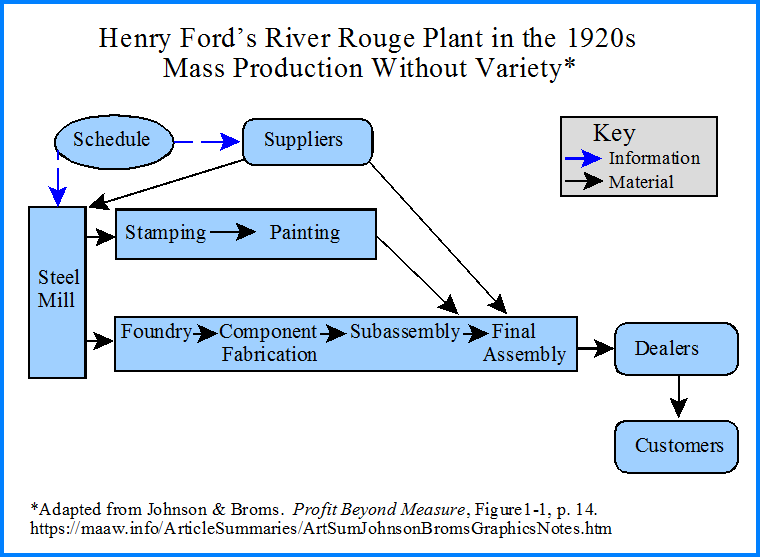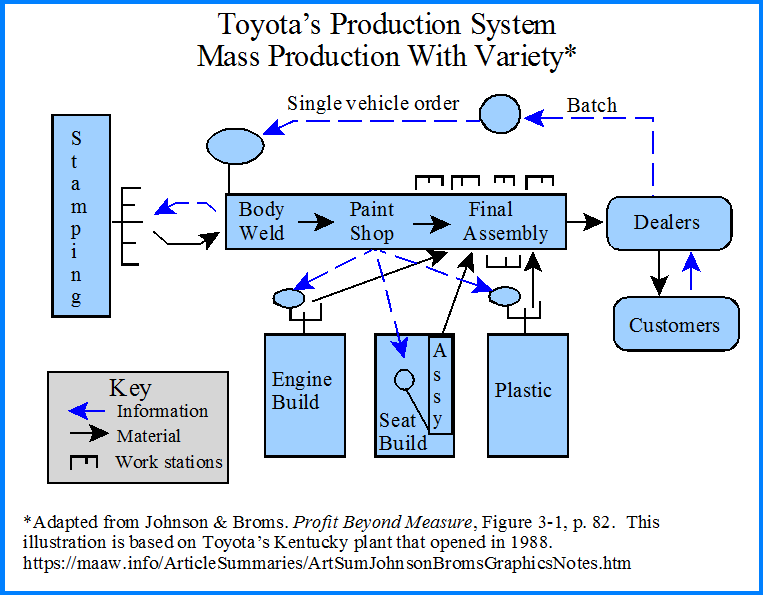
Provided by James R. Martin, Ph.D., CMA
Professor Emeritus, University of South Florida
History & Development Main Page |
Relevance Regained Main Page
The purpose of this section is to provide some graphics and additional notes to supplement Chris Hourigan's summary of Johnson, H. T. and A. Broms. 2000. Profit Beyond Measure: Extraordinary Results through Attention to Work and People. The Free Press.
The graphic illustration of Ford's River Rouge Plant below conveys the plant layout and Ford's underlying strategy. The idea was to produce a continuous flow of Model-T Fords as fast as possible to obtain the lowest possible cost per unit. Every automobile was essentially identical.

However, after World War II, customers wanted more variety. This called for a different type of organization. The graphic below illustrates what the Big three auto makers created to obtain variety in response to what they saw at Henry Ford's River Rouge Plant in the 1920s. Departments were separated or decoupled to allow each operation to produce batches according to its own changeover system. Parts were then moved to a central warehouse and stored until they were needed at the assembly plant. According to Johnson, this approach created a huge "information factory" that would eventually employ more workers than the real factory or "materials flow factory".
The Big Three believed they could control the additional cost of the information factory with the mass production economies of scale approach, but the decoupling created additional cost, activities and problems such as:
1. additional inventories and warehouses,
2. a needed for production controllers and schedulers to coordinate the movement of materials from the production stages to the warehouse and then to final assembly,
3. building inventory, scraping excess, additional advertising etc. to balance the output with customer demand,
4. undetected errors and defects in the final products,
5. increasing the capacity of machinery to accommodate different changeover rhythms, and
6. offering performance incentives that disrupted harmony and created higher costs.
An underlying strategic assumption of the Big Three was that a company must choose between differentiation and mass production. Their view was that differentiation causes a company to sacrifice economies of scale. The extra variety would cause complexity and extra costs. But Johnson says they failed to recognize that the extra complexity might be due to the way the work was organized.
Toyota's leaders did not view Ford's River Rouge plant from the same perspective. Instead they saw a holistic pattern of work flowing continuously at the same rate through each operation where each step consumed only what was needed by the next step. They saw that balancing the flow of work conserves resources and allows variety to be achieved at no greater costs than when identical units were mass produced. The key to achieving variety, from Toyota's perspective, was to reduce changeover times while keeping all steps connected in a continuous flow of work. Each step connects specific workers with the needs of specific customers, i.e., the person in the next operation downstream. Johnson describes the flow of material and work as much like the metabolic flow that sustains a living organism with feedback flowing through the web of relationships so that every worker always has the information needed to perform the work. This form of organization eliminates the need for the costly "information factory" required by the Big Three. In Toyota's system, the work is the information.
The following illustration provides a graphic view of Toyota's production layout and their continuous flow concept. Customer order information is used to pull material through the plant as indicated by the blue arrows in the exhibit. The flow of work is guided at each step by the information in the dealer's initial order.

____________________________________________________
Related summaries:
Hammer, M. 1990. Reengineering work: Don't automate, obliterate. Harvard Business Review (July-August): 104-112. (Summary).
Hammer, M. 2001. The superefficient company. Harvard Business Review (September): 82-91. (Summary).
Hammer, M. 2007. The process audit. Harvard Business Review (April): 111-123. (Note).
Johnson, H. T. and A. Broms. 2000. Profit Beyond Measure: Extraordinary Results through Attention to Work and People. The Free Press. (Summary).
Johnson, H. T. 2006. Sustainability and "Lean Operations". Cost Management (March/April): 40-45. (Summary).
Martin, J. R. Not dated. Russell Ackoff quotes and f-laws. Management And Accounting Web. Russell Ackoff
Martin, J. R. Not dated. Russell Ackoff: What is a system? Videos. Management And Accounting Web. Russell Ackoff Videos
Martin, J. R. Not dated. The Beer Game. Management And Accounting Web. The Beer Game
Senge, P. M. 1990. The Fifth Discipline: The Art and Practice of the Learning Organization. Doubleday Currency. (Note).
Spear, S. and H. K. Bowen. 1999. Decoding the DNA of the Toyota production system. Harvard Business Review (September-October): 97-106. (Summary).
Toyota Public Affairs Division and Operations Management Consulting Division. 1998. The Toyota Production System: Leaner Manufacturing for a Greener Planet. The Toyota Motor Corporation. (Summary).